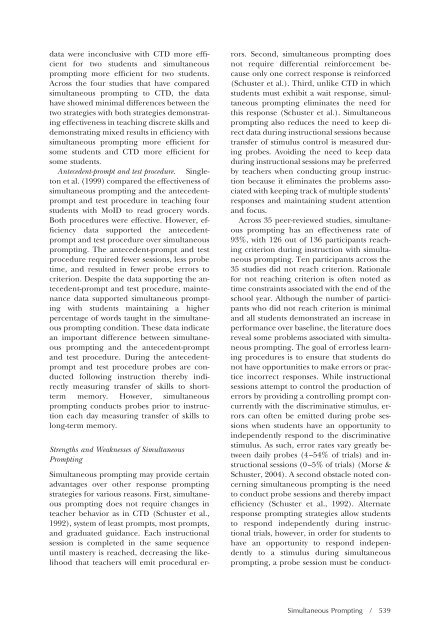etadd_46(4) - Division on Autism and Developmental Disabilities
etadd_46(4) - Division on Autism and Developmental Disabilities
etadd_46(4) - Division on Autism and Developmental Disabilities
You also want an ePaper? Increase the reach of your titles
YUMPU automatically turns print PDFs into web optimized ePapers that Google loves.
data were inc<strong>on</strong>clusive with CTD more efficient<br />
for two students <strong>and</strong> simultaneous<br />
prompting more efficient for two students.<br />
Across the four studies that have compared<br />
simultaneous prompting to CTD, the data<br />
have showed minimal differences between the<br />
two strategies with both strategies dem<strong>on</strong>strating<br />
effectiveness in teaching discrete skills <strong>and</strong><br />
dem<strong>on</strong>strating mixed results in efficiency with<br />
simultaneous prompting more efficient for<br />
some students <strong>and</strong> CTD more efficient for<br />
some students.<br />
Antecedent-prompt <strong>and</strong> test procedure. Singlet<strong>on</strong><br />
et al. (1999) compared the effectiveness of<br />
simultaneous prompting <strong>and</strong> the antecedentprompt<br />
<strong>and</strong> test procedure in teaching four<br />
students with MoID to read grocery words.<br />
Both procedures were effective. However, efficiency<br />
data supported the antecedentprompt<br />
<strong>and</strong> test procedure over simultaneous<br />
prompting. The antecedent-prompt <strong>and</strong> test<br />
procedure required fewer sessi<strong>on</strong>s, less probe<br />
time, <strong>and</strong> resulted in fewer probe errors to<br />
criteri<strong>on</strong>. Despite the data supporting the antecedent-prompt<br />
<strong>and</strong> test procedure, maintenance<br />
data supported simultaneous prompting<br />
with students maintaining a higher<br />
percentage of words taught in the simultaneous<br />
prompting c<strong>on</strong>diti<strong>on</strong>. These data indicate<br />
an important difference between simultaneous<br />
prompting <strong>and</strong> the antecedent-prompt<br />
<strong>and</strong> test procedure. During the antecedentprompt<br />
<strong>and</strong> test procedure probes are c<strong>on</strong>ducted<br />
following instructi<strong>on</strong> thereby indirectly<br />
measuring transfer of skills to shortterm<br />
memory. However, simultaneous<br />
prompting c<strong>on</strong>ducts probes prior to instructi<strong>on</strong><br />
each day measuring transfer of skills to<br />
l<strong>on</strong>g-term memory.<br />
Strengths <strong>and</strong> Weaknesses of Simultaneous<br />
Prompting<br />
Simultaneous prompting may provide certain<br />
advantages over other resp<strong>on</strong>se prompting<br />
strategies for various reas<strong>on</strong>s. First, simultaneous<br />
prompting does not require changes in<br />
teacher behavior as in CTD (Schuster et al.,<br />
1992), system of least prompts, most prompts,<br />
<strong>and</strong> graduated guidance. Each instructi<strong>on</strong>al<br />
sessi<strong>on</strong> is completed in the same sequence<br />
until mastery is reached, decreasing the likelihood<br />
that teachers will emit procedural er-<br />
rors. Sec<strong>on</strong>d, simultaneous prompting does<br />
not require differential reinforcement because<br />
<strong>on</strong>ly <strong>on</strong>e correct resp<strong>on</strong>se is reinforced<br />
(Schuster et al.). Third, unlike CTD in which<br />
students must exhibit a wait resp<strong>on</strong>se, simultaneous<br />
prompting eliminates the need for<br />
this resp<strong>on</strong>se (Schuster et al.). Simultaneous<br />
prompting also reduces the need to keep direct<br />
data during instructi<strong>on</strong>al sessi<strong>on</strong>s because<br />
transfer of stimulus c<strong>on</strong>trol is measured during<br />
probes. Avoiding the need to keep data<br />
during instructi<strong>on</strong>al sessi<strong>on</strong>s may be preferred<br />
by teachers when c<strong>on</strong>ducting group instructi<strong>on</strong><br />
because it eliminates the problems associated<br />
with keeping track of multiple students’<br />
resp<strong>on</strong>ses <strong>and</strong> maintaining student attenti<strong>on</strong><br />
<strong>and</strong> focus.<br />
Across 35 peer-reviewed studies, simultaneous<br />
prompting has an effectiveness rate of<br />
93%, with 126 out of 136 participants reaching<br />
criteri<strong>on</strong> during instructi<strong>on</strong> with simultaneous<br />
prompting. Ten participants across the<br />
35 studies did not reach criteri<strong>on</strong>. Rati<strong>on</strong>ale<br />
for not reaching criteri<strong>on</strong> is often noted as<br />
time c<strong>on</strong>straints associated with the end of the<br />
school year. Although the number of participants<br />
who did not reach criteri<strong>on</strong> is minimal<br />
<strong>and</strong> all students dem<strong>on</strong>strated an increase in<br />
performance over baseline, the literature does<br />
reveal some problems associated with simultaneous<br />
prompting. The goal of errorless learning<br />
procedures is to ensure that students do<br />
not have opportunities to make errors or practice<br />
incorrect resp<strong>on</strong>ses. While instructi<strong>on</strong>al<br />
sessi<strong>on</strong>s attempt to c<strong>on</strong>trol the producti<strong>on</strong> of<br />
errors by providing a c<strong>on</strong>trolling prompt c<strong>on</strong>currently<br />
with the discriminative stimulus, errors<br />
can often be emitted during probe sessi<strong>on</strong>s<br />
when students have an opportunity to<br />
independently resp<strong>on</strong>d to the discriminative<br />
stimulus. As such, error rates vary greatly between<br />
daily probes (4–54% of trials) <strong>and</strong> instructi<strong>on</strong>al<br />
sessi<strong>on</strong>s (0–5% of trials) (Morse &<br />
Schuster, 2004). A sec<strong>on</strong>d obstacle noted c<strong>on</strong>cerning<br />
simultaneous prompting is the need<br />
to c<strong>on</strong>duct probe sessi<strong>on</strong>s <strong>and</strong> thereby impact<br />
efficiency (Schuster et al., 1992). Alternate<br />
resp<strong>on</strong>se prompting strategies allow students<br />
to resp<strong>on</strong>d independently during instructi<strong>on</strong>al<br />
trials, however, in order for students to<br />
have an opportunity to resp<strong>on</strong>d independently<br />
to a stimulus during simultaneous<br />
prompting, a probe sessi<strong>on</strong> must be c<strong>on</strong>duct-<br />
Simultaneous Prompting / 539
















